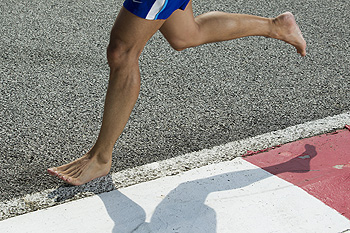 The Achilles tendon is the thick band on the back of the ankle that connects the calf muscle to the heel bone. Achilles tendon injuries are often overuse injuries or sudden traumas. One common injury, Achilles tendonitis, occurs when the tendon becomes inflamed near its connection to the heel bone. Achilles tendon ruptures are also common, and they can be very painful and may take a long time to heal. Because a lack of flexibility is the most common cause of injury to the Achilles tendon, proper stretching of the lower legs before working out is the most important step to prevent an injury. When healing from the injury, non-impact exercises, such as swimming and cycling, are highly suggested to keep you as in shape as possible. If you have questions about preventing an injury, or you believe you may have injured your Achilles tendon, please consult with a podiatrist.
The Achilles tendon is the thick band on the back of the ankle that connects the calf muscle to the heel bone. Achilles tendon injuries are often overuse injuries or sudden traumas. One common injury, Achilles tendonitis, occurs when the tendon becomes inflamed near its connection to the heel bone. Achilles tendon ruptures are also common, and they can be very painful and may take a long time to heal. Because a lack of flexibility is the most common cause of injury to the Achilles tendon, proper stretching of the lower legs before working out is the most important step to prevent an injury. When healing from the injury, non-impact exercises, such as swimming and cycling, are highly suggested to keep you as in shape as possible. If you have questions about preventing an injury, or you believe you may have injured your Achilles tendon, please consult with a podiatrist.
Achilles tendon injuries need immediate attention to avoid future complications. If you have any concerns, contact one of our podiatrists of Illinois . Our doctors can provide the care you need to keep you pain-free and on your feet.
What Is the Achilles Tendon?
The Achilles tendon is a tendon that connects the lower leg muscles and calf to the heel of the foot. It is the strongest tendon in the human body and is essential for making movement possible. Because this tendon is such an integral part of the body, any injuries to it can create immense difficulties and should immediately be presented to a doctor.
What Are the Symptoms of an Achilles Tendon Injury?
There are various types of injuries that can affect the Achilles tendon. The two most common injuries are Achilles tendinitis and ruptures of the tendon.
Achilles Tendinitis Symptoms
- Inflammation
- Dull to severe pain
- Increased blood flow to the tendon
- Thickening of the tendon
Rupture Symptoms
- Extreme pain and swelling in the foot
- Total immobility
Treatment and Prevention
Achilles tendon injuries are diagnosed by a thorough physical evaluation, which can include an MRI. Treatment involves rest, physical therapy, and in some cases, surgery. However, various preventative measures can be taken to avoid these injuries, such as:
- Thorough stretching of the tendon before and after exercise
- Strengthening exercises like calf raises, squats, leg curls, leg extensions, leg raises, lunges, and leg presses
If you have any questions please feel free to contact our offices located in Wheeling and Berwyn, IL . We offer the newest diagnostic tools and technology to treat your foot and ankle needs.




